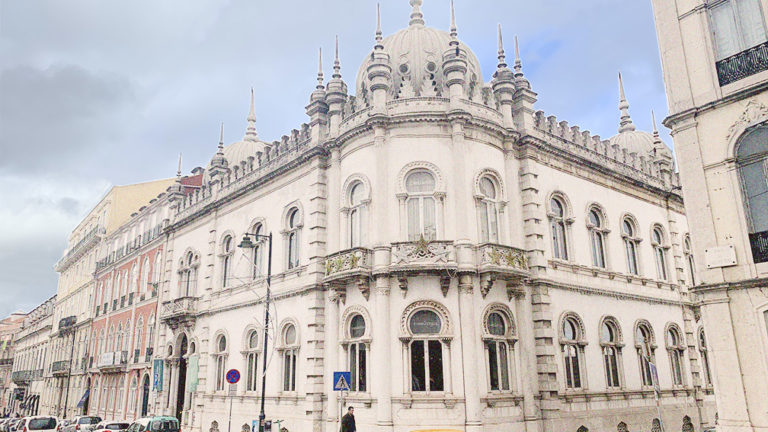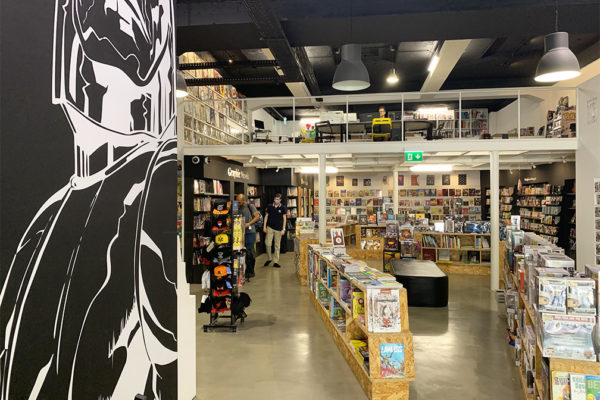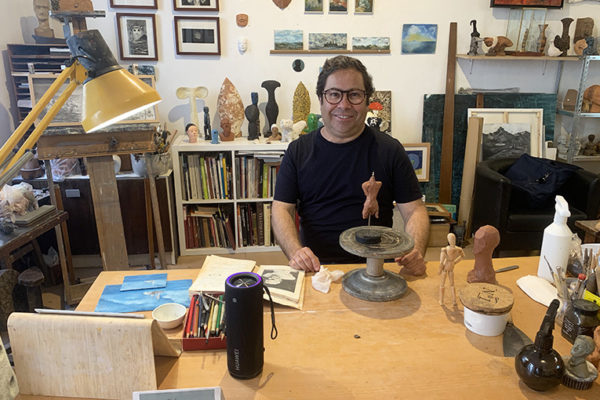What are the traces of the influence of the ancient Caliphates on the Iberian Peninsula and particularly in Lisbon? Marc Terrisse, historian and author of the book: "Lisbon in the Muslim City" tells us some historical secrets.
When did you decide to write about the Muslim history of Lisbon?
It came naturally to me last year during a trip to Lisbon in 2016. I hadn't been back to Lisbon for a long time, it must have been more than ten years ago. I had just finished reading a colleague's book called "Lisbon in the Black City" by Jean-Yves Loude. And as I was walking around the city, I thought that with all this Muslim past, this Islamic past, it deserved to be explored in greater depth and to be given more prominence. In the city, except for the castle St JorgeThere are some excavations in the cathedral which have not been really promoted, so I thought "there is a job to do to unearth all this"! There are excavations in the cathedral that have not really been valued, so I said to myself "there is work to be done to exhume all this"! both for the medieval Islamic period, but also to show that there were relations with the Near East. In my book, I describe the exchanges between the Iberian Peninsula and the Eastern world, the different peoples like the Venetians and others who contributed to the birth of Portugal. After this Islamic period, the Muslim presence did not stop at the time of the Christian reconquest in 114, because there were populations that remained, and others that arrived with the Portuguese expansion. Then, even today, it is enough to walk around the district of MourariaWe can see very clearly a small community that exists in the city with the mosque. I also wanted to shed light on the contemporary period, on the 19th, 20th and 21st centuries.
Is Lisbon a city you knew before writing this book?
Yes, I knew Lisbon and Portugal. I really like the country and its capital, I think you can feel it in the book. It's a fascinating and captivating city that is, perhaps, a little too successful at the moment. A lot of people from different backgrounds are moving to the metropolis today, but it is a city that offers a certain quality of life and its urbanism reminds me of the Orient. For me, it is the most western city in Europe, because it is on the extreme western side of Europe and at the same time it is perhaps the most eastern city in Europe in terms of its atmosphere, with a certain nonchalance. This contributed a lot to the writing of this book.
What does your job as a doctor of history involve?
I like writing, doing historical research, and over time I have specialised in museology. I think that shows in my writing style because there is the idea of ballads. This is very much linked to my profession, which is museology, so the history of museums. I am a researcher at the CNRS, so I write articles related to museums and good year bad year I've been interested in minorities, whether it's ethnic minorities, social minorities or LGBT+ minorities, but originally I was more interested in European Muslim minorities. So this book is also related to museology because I'm interested in the histories of minorities in Europe and the Jewish minority and it's all partly related. I work on African minorities in Europe, and Lisbon has an important role in the European history of African minorities. I am also interested in working on ethnic, social and sexual minorities.
Are you an authentic researcher, looking for moments in history that have been forgotten?
Yes, exactly, on moments in history that have not been worked on too much, or that have been forgotten and that for various reasons, for a dominant discourse that is a bit comfortable, have not been exhumed.
Lisbon is a city rich in history and culture. Is the influence of the Muslim epic and the oriental world still present?
Yes, the oriental world is present in Lisbon through different places. St Jorge's Castle, an emblematic place of the city that keeps in memory the epic of the Moors, has an archaeological site that is very well done. This fortified castle is the former residence of the governors of Lisbon, where there was a casbah. You also have under the cathedral the remains of the mosque, even if it is not very well developed. Right next to the cathedral, you have the prison of Aljube which is now a museum, Aljube being a name of Arabic origin. You also have the archaeological nuclei that are found in the lower town, Baixa, In this district you have examples from the Venetian, Visigoth, Muslim and Gothic periods. And then you also have the names of the streets, of the districts, Alfama for example, it is a name of Arabic origin, it comes from "masdar almiah", the source of water, also the district Alcântara which comes from "Al-qantara" which means bridge in Arabic. There are many names of Arabic origin that have remained, as well as neo-Moorish buildings built in the 19th century, at the time of a certain renaissance, with the Lisbon bullring in Campo Pequenoand the casa do Alentejo. And of course the Mourariabetween the square Martim Moniz and the castle São Jorgewhere the Muslims remained after the reconquest. The MourariaThe town of St. Petersburg, at that time, was a municipality that was more or less subject to the royal power but had a certain degree of autonomy, and then lost its independence. The inhabitants found themselves somewhat enclosed in a ghetto, especially from the 14th century onwards. Today in Martim Moniz, you still have a Central Asian Muslim population from Pakistan, Bangladesh that is very present in this area.
The Muslim population, not very visible, has been living here for a long time, you can hear Moroccan spoken, there are links between Morocco and Portugal, which are very old. At the time, the Muslim empires, which included present-day Morocco and a large part of the Maghreb, owned most of the Iberian Peninsula, such as the territory of Al-Andalus, which was under Arab jurisdiction from 711 to 1492. The Portuguese were the first Europeans, with the capture of Ceuta in 1415, to create colonies and trading posts in Morocco. They had a constellation of trading posts on the African coast, including the best known of the explorers Fernand Magellan from the time of the Great Discoveries.
Over the centuries, the ancestral links between the two countries have grown. In 1578, Sebastanism, a Portuguese belief, hopes for the return of the young King Sebastian I to the Portuguese throne.erThis "battle" was between the new Moroccan Sultan and the old Sultan, who was allied with the Portuguese King Sebastian. A real interconnection was established between the two regions, almost a community of destiny between Portugal and Morocco, celebrated in the 80s by King Hassan II and Mário Soares, through cultural institutions and in Morocco, in Mazagan, which is the old Portuguese name for the town of El Jabida, on the central coast of Moroccan territory. Some Moroccan towns have very interesting Portuguese architecture, and important economic links have been forged. This also contributes to the luso-oriental atmosphere that can be found in Lisbon.
And then there is also the history of Mouros (Moors), a different history compared to Spain, the Muslim populations remained after the reconquest. In Portugal, this has a different meaning, because the Mouros are Moroccan slaves who were mainly brought by the trading posts in the 15th and 16th centuries. There were a lot of them in Lisbon, but not all of them were slaves, there were also Moroccan nobles who had supported Don Sebastian, so they were forced to leave Morocco and settle in Lisbon, but I don't want to give everything away, I'll talk about that in my book.
I really liked the way you bring the story to life in your book. You walk around Lisbon, you describe the monuments, the history of the neighbourhoods and you share your encounters. Is this your way of telling the story?
Absolutely, I had done a presentation in a bookshop in Paris, and the person who had interviewed me also had a very good grasp of it, and I couldn't have found better words to describe a little bit the way I did it. She said it was like an open-air human science research notebook. You have shown how a researcher in human science, a multidisciplinary researcher, can approach a subject from history, anthropology, geography, ethnology, museology. There are also many things like sociology. So the idea for the construction of the book is that everything is sourced, both the monuments and the people. Orality is interesting, as are the meetings and, of course, the more classic sources linked to the written word or other sources that I consulted. Everything becomes a source and everything helps to produce a discourse. Through the ballad, I tried to make the reading enjoyable, as if I were the reader and he was living the investigation with me. An investigation in human science with clues, each time we move through the streets of Lisbon, which is rather pleasant.
If you know Lisbon a little bit, it's very pleasant, it's like walking through the city with you and you recognize the places you describe very well.
Did the trade routes from the Maghreb via Gibraltar to the Lusophone lands bring unique skills or construction techniques?
The Portuguese architectural style, Manueline art, which is flamboyant Gothic, takes its stylistic codes partly from Islamic art. In Lisbon you have the Hieronymites' monastery and the tower of Belém which are in the Manueline style. The resemblance with oriental architecture is evident in the style, and this is even more true in the south of Portugal in the region of the Alentejo and the Algarveespecially in the Alentejo where, really, you have the outdated arts, the Islamic arts that are in the Manueline style. This can also be felt in Lisbon through several constructions. Indeed, there are these craftsmen who stay on site, who will transmit techniques which will be taken up later by Portuguese craftsmen. This is typically seen in the manual arts, but there are other things too, such as the heritage, for example, through the small trades that have now disappeared from Lisbon. But you could still see in Lisbon in the first half of the 20th century, and even in the 1970s, small trades that corresponded a lot to what you would find in the souks, such as hawkers. It's quite obvious, there are engravings and photos that show these trades, these artists who will remain in the city, and who will influence Portuguese culture in some way. We can speak of a Luso-Islamic culture in the long term.
Can you tell us a story about a Caliphate in Portugal?
Yes, there are many legends. When the kingdom of the Omeiad caliphate of Cordoba broke up, several principalities called taifa were created under this division. But Lisbon never managed to have its own taifa. Lisbon has never been an independent principality. It was always under the control of Seville or Badajoz, but at one point you have the Emir of Zaragoza who came to settle in Lisbon. He brought a lot of intellectuals, poets, artists of the time, who created a small court, which was very short-lived in the middle of the 11th century. But nevertheless, Lisbon, at the time, had a certain influence. In Portugal, around Beja and Medoura that's where there's going to be TaifasThese are principalities, because they are cities that are a little more important than Lisbon in the Muslim era from a cultural point of view.
For the anecdotes, actually, there are more legends with Moorish princesses who stayed after the reconquest. Like Fatima, for example, typically she is a Moorish princess who was kidnapped by a Christian nobleman. They got married, so she changed her name. She was called Oriane in French, in Portuguese it must be Ouréana. Then, to pay homage to this Fatima who became Ouréana, the locality of the time took the name of Fatima, which has now become a high place of Christianity. Anthropological theories say that Fatima is in fact the extension of a Muslim cult dedicated to the daughter of the prophet Mohammed. So Fatima is a kind of syncretism with the Christian religion with Mary and Fatima.
Then you have other Moorish legends, like the princess Salúquia, a young Moorish girl who is going to get married, but her companion goes into the wild, we don't really know why. And then he is killed by the Christians who take his appearance. Salúquia is at the top of the tower, she watches for his arrival and sees these characters in disguise, she thinks it's her husband and opens the doors, only to realise too late that it's a deception. They massacre the population. She throws herself off the tower. So the locality, to pay homage to this legend, gives the name of Moura, Moorish in French, to this town which is in Alentejo.
Another legend, in the Algarve you have a Moorish princess who one night asks men to marry her so that she can return to the Maghreb, where her family was massacred. To be at peace, she would like to return there. There are many legends in the Lisbon area. Maybe this is the next book, all these stories.
Does Lisbon have the same pace of life as another city under the caliphate?
So the importance of Lisbon for the Umayyads, a dynasty originating from Syria, and later for the other masters of the Muslim places, was its commercial importance. It was not a real intellectual capital except during a short interlude that I mentioned earlier, but it was above all a commercial city that served as a base for certain extra-maritime expeditions - as was the case at the time of the expedition with the Portuguese kings. It was a fairly large city, the figures are always random, not as large as Seville or probably Beja, but still a fairly important city at the level of the Gharb al Andalus (the region that encompassed Lisbon), prized for its commercial and maritime importance essentially. It was integrated into this network of cities in western Andalusia, after the Moorish conquest, Lisbon was renamed al-Ushbuna لشبونة and also al-Lixbûnâ اليكسبونا which gave Lisboa.
What is your next research and book?
I have a book about Portugal that is going to be published by Cosmopole. In this book, I don't only talk about the Islamic past, I also talk about the Judaic past, the Portuguese Africanism, ... It's a travel essay that made me want to go to Portugal. It will be published in spring 2023 by Cosmopole, I also invite you to read the unusual dictionary of Lisbon, it is very nice. Cosmopole is making a new collection that will be released in the spring. I have another book that will come out perhaps in November, about New York, called "New York Portrait of an Arab City". It's about the Arabs who went to New York, especially the Syrian-Lebanese from the 19th century to the beginning of the 20th century (including Gibran Khalil Gibran, the writer of The Prophet, who wrote in English, by the way), about the Syrian-Lebanese diaspora, about the Syrians and Lebanese who went to New York from the end of the 19th century to the Second World War, and also about the Palestinians and Yemenis and other communities who participated in New York's intellectual life in various ways. I tell the story of these expatriates in the same narrative model as "Lisbon in the Muslim City" but this takes place in New York.
Marc Terrisse: Lisbon, in the Muslim city of the Chandeigne editions.


